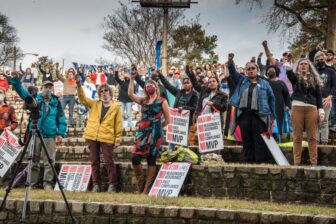By Maria Gallucci
A Dominion shareholder movement sparked by one woman provoked a record vote on one of its resolutions. ‘This seems like a climate wake-up call.’
In 2008, Virginia resident Ruth McElroy Amundsen took her first stab at using shareholder activism to spur action on climate change—she introduced a resolution that challenged Dominion Resources Inc., Virginia’s largest emitter of greenhouse gases, to get more of its electricity from renewables.
Since then the 51-year-old NASA engineer and mother of two has helped spark a growing movement to pressure Dominion to respond to global warming concerns. Last month, the informal network of 20 activists achieved its biggest success yet: Shareholders representing nearly a quarter of Dominion’s shares voted “yes” on a proposal to require the utility to report to investors on the financial risks that climate change poses to its business.
That wasn’t enough to pass the resolution, but it was by far the highest number of “yes” votes ever cast for a climate resolution to Dominion. It was a surprising result, the activists say, because the company has been particularly resistant to climate and renewable energy policies.
Dominion, one of the nation’s largest producers and transporters of energy, ranked 187 on the 2012 Fortune 500. The vote represented about $7.6 billion worth of the company’s shares.
The vote “sent a real message that you’re getting beyond just the die-hard environmentalists,” said Seth Heald, a lawyer and a member of the activist network. “You’re getting to real investors who are seriously concerned for business reasons about the risk [of climate change].”
The momentum in Virginia is part of a wave of Wall Street activism that has seen shareholder groups and individuals use resolutions to call on utilities and other companies to disclose the risks they could face from extreme weather and carbon regulations. The newest are “carbon bubble” resolutions, which ask fossil fuel companies to reveal how much of their assets would be left “stranded” in the ground if the nation enacts sweeping climate policy.
Amundsen, whose home has a solar-paneled roof, said she was driven to act because of the slow pace of Dominion’s renewable energy transformation amid global warming. “I felt like they were not looking long-term enough,” she said. “I hate the idea that my kids won’t be able to experience the same kind of world as I have.”
Richmond-based Dominion generates nearly all of its electricity from a mix of coal, natural gas and nuclear. It is Virginia’s biggest carbon polluter, according to federal data on large facilities. It has also supported efforts to weaken the state’s voluntary renewable energy target of 15 percent renewables by 2025.
Two percent of Dominion’s electricity supply comes from renewables—mainly from hydropower plus some wind, solar and biomass. The figure nationally is 13 percent.
Dominion spokesman Ryan Frazier did not respond to questions about the activists’ criticism and the shareholder resolution that won record support. But he said the utility expects to boost its renewable energy portfolio in Virginia this year as three biomass power plants, which burn plant and tree matter to generate electricity, come online. Dominion is also considering plans to develop onshore and offshore wind farms and is working with businesses to install solar energy systems.
A Shareholder Movement Is Born
Amundsen bought Dominion shares in 2005 to get the conversation started about renewable energy. She said she was “very naïve about shareholder activism” and didn’t know she could appeal to investors. So she sent the utility a letter proposing ways in which it could invest in renewable power projects, like pilot solar installations. The letter resulted in a teleconference with Dominion officials, but nothing after that.
Three years later, Amundsen submitted her first resolution urging the company to set a goal of getting 80 percent of its electricity from non-fossil fuel sources by 2020. She introduced the proposal at the Dominion shareholder meeting, where presenters are allowed to deliver a three-minute pitch to board members—often from the rear of the room. “You’re staring at 200 backs of people in blue suits,” Amundsen said.
The resolution got four percent of the vote, representing about $820 million in Dominion shares at the time, she said.
At the end of the meeting, shareholders asked Amundsen if she had collaborated with groups like Ceres, a coalition of sustainability focused investors with $11 trillion in assets. She hadn’t, but she quickly reached out to the organization. Discovering that activists were working together on similar proposals was “empowering,” she said.
“I have a full-time job, I have two kids. This is something I do in the little free time I have. It was really an incredible feeling of support … I felt like we could do a much more comprehensive job.”
The activists, led by organizers at Ceres and the Sierra Club, began reviewing and discussing each other’s proposals, studying existing resolutions and sharing research and data to bolster their arguments. The collaboration marked the start of an organized shareholder movement in Virginia—one that is “fairly unique” among activists in the United States because it focuses on a single company, said Dan Bakal, director of Ceres’ Electric Power Program.
Beth Kemler, the Virginia state director of the Chesapeake Climate Action Network (CCAN), said she began working with Amundsen in 2011. She said volunteers with her group started buying shares in Dominion so they could submit their own resolutions. “They were inspired by her, basically,” Kemler said.
Phillip Ellis, a former coordinator at the Sierra Club’s Virginia chapter, said the network has about 20 active volunteers who craft resolutions and promote them to proxy advisory firms like Institutional Shareholder Services and Glass Lewis, which help institutional investors decide how to vote. The activists also present the proposals at annual Dominion shareholder meetings.
It was Kemler of CCAN who wrote this year’s climate change resolution that got an unprecedented 22.6 percent of the vote. “This seems like a climate wake-up call” for shareholders, she said.
Dominion tried to keep the resolution off the ballot by filing a “no-action” letter to the U.S. Securities and Exchange Commission (SEC). The company said the proposal wasn’t needed because the company had reported its potential climate liabilities to the Carbon Disclosure Project, a nonprofit that helps firms develop carbon-cutting strategies. Further, Dominion had filed a similar report to the SEC in its annual 10-K financial filing.
But the SEC advised Dominion to bring Kemler’s resolution to a vote.
“Based on the information you have presented, it does not appear that Dominion’s public disclosures compare favorably with the guidelines” of the resolution, an SEC attorney wrote in a February 5 letter.
Dominion included the resolution on its ballot, but strongly urged shareholders to vote against it. In its 2013 proxy statement, a 72-page document provided ahead of its May 3 shareholder meeting, the utility explained that it “has provided, and intends to continue to provide, appropriate disclosures to its investors regarding climate change and the risks it poses to Dominion. We believe that preparation of the requested report would be duplicative and an unnecessary waste of company resources.”
Kemler’s proposal was one of three climate resolutions brought to a vote this year at Dominion’s annual shareholder meeting. The second urged Dominion to write a report about how the company could end its use of coal produced through mount
aintop removal mining. The third proposal—which was filed by Amundsen—sought to make sustainability progress one of the performance measures that Dominion considers when setting senior executive compensation. Both of those measures received about 7 percent of the vote.
Activists in the Virginia network filed four other climate resolutions, but Dominion omitted them from its voting materials. The Presbyterian Church USA filed a related resolution of its own that was also excluded.
The same type of activism is happening with other companies.
According to Ceres, 100 resolutions related to climate and environmental issues were filed in the 2013 U.S. proxy season. The resolution with the highest percentage of votes—which passed with 67 percent—was a proposal to require Illinois-based CF Industries Holdings, a producer of nitrogen fertilizer, to write its first sustainability report and increase the energy efficiency of its operations.
Amundsen plans to submit another resolution for the company’s next annual meeting, but she hasn’t started working on it yet.
“It’s emotionally hard to go to that [shareholder] meeting, and I like to have a little bit of downtime to recoup,” she said.
While getting a resolution passed would be ideal, she said her main goal is to educate Dominion executives and investors about the clean energy transformation taking place in other parts of the country.
“If you bring these things up in a shareholder meeting, and give a speech about better choices that other energy companies are making, I look on that as a chance for some education,” Amundsen said.




